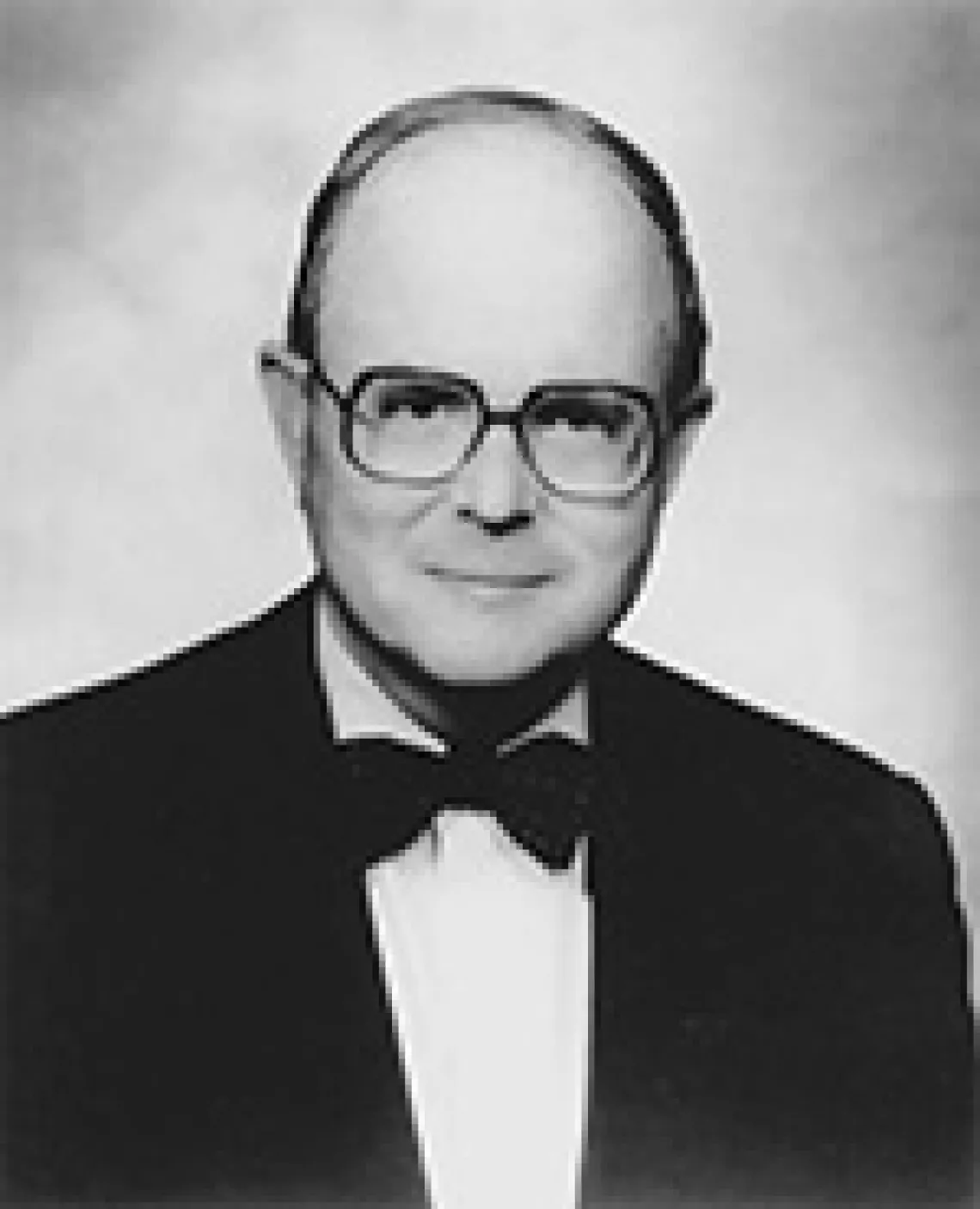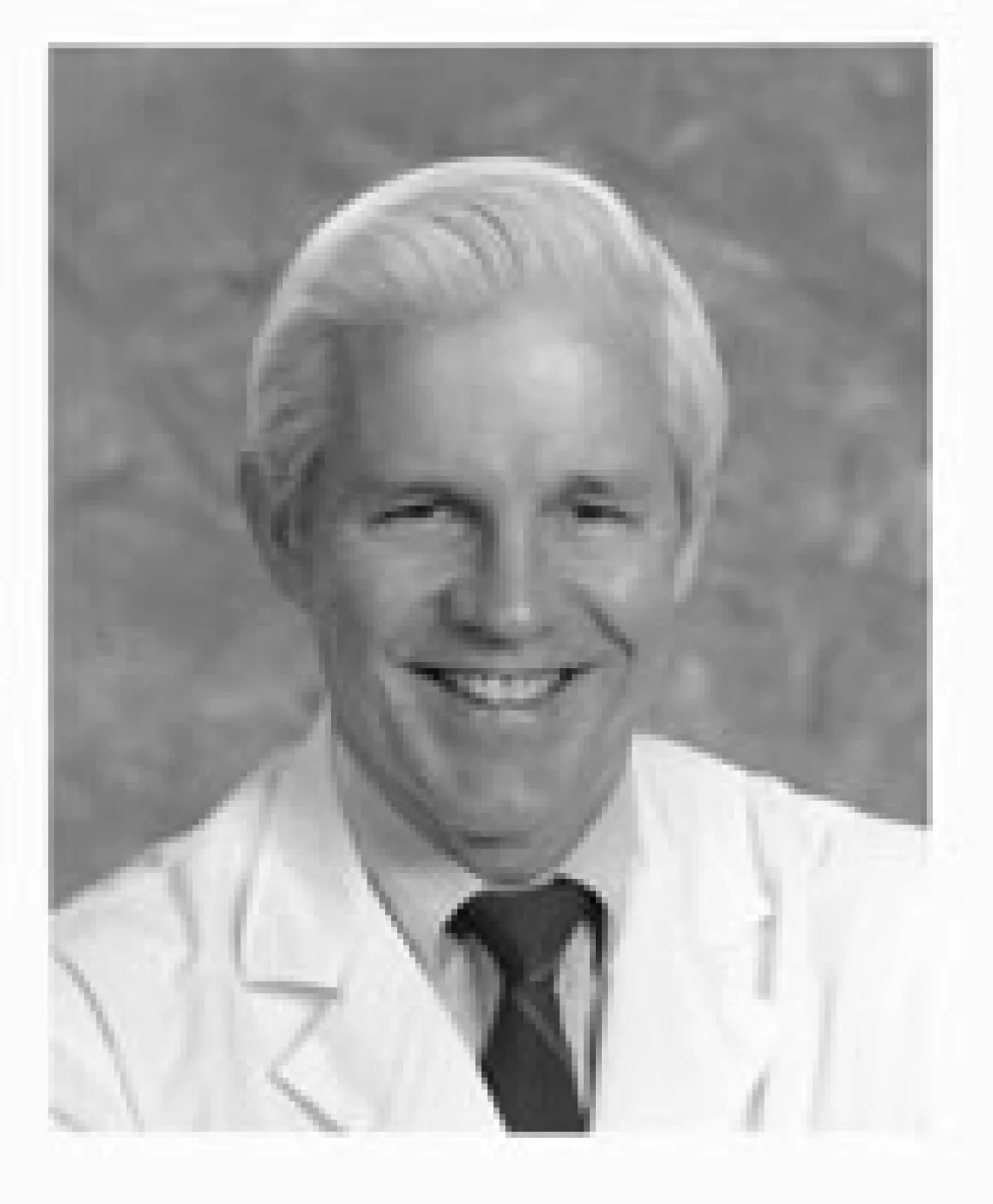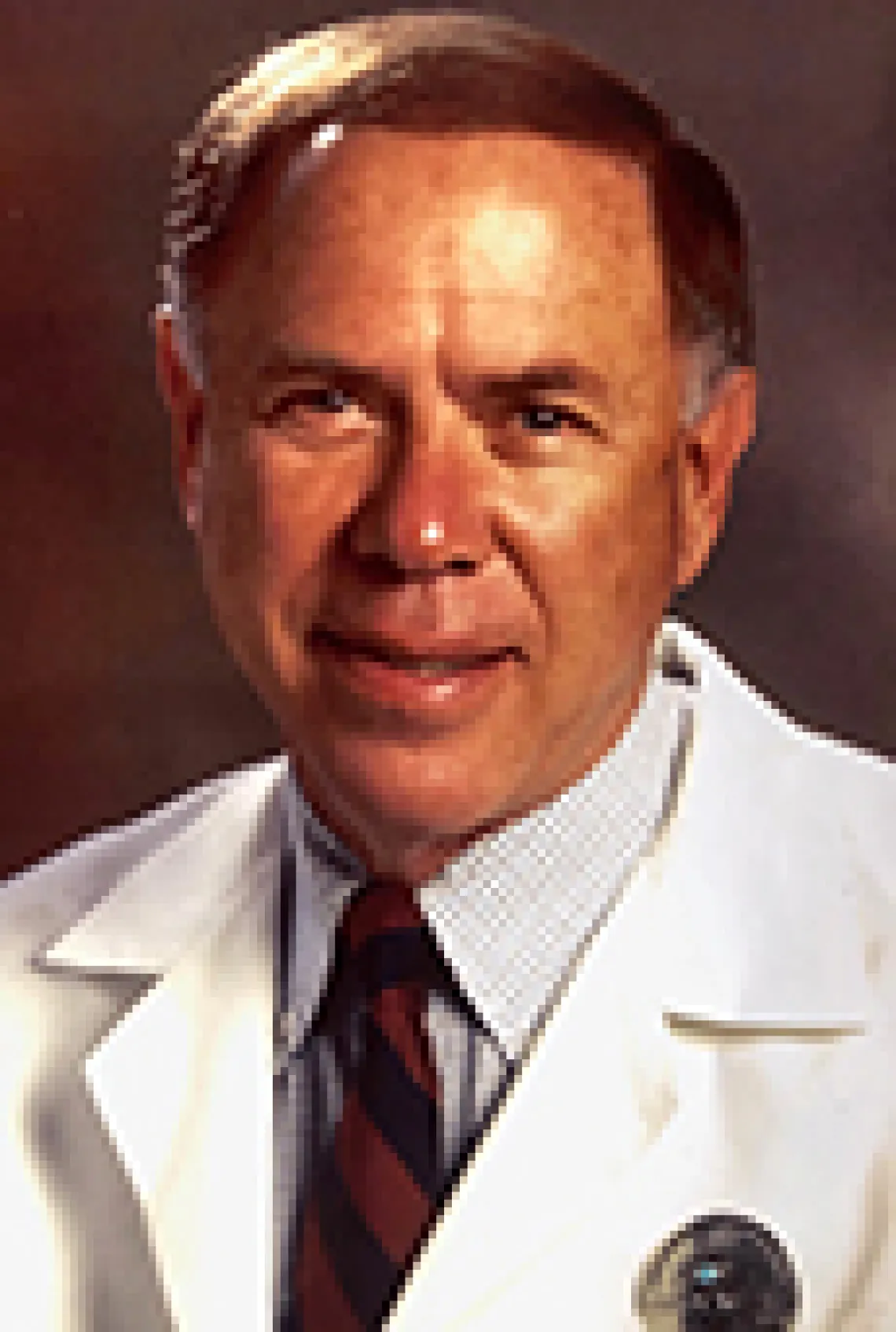The UA Department of Orthopaedic Surgery proudly follows in a tradition of outstanding leaders in orthopaedics including Leonard F. Peltier, MD, PhD; Donald P. Speer, MD; and Robert G. Volz, MD.
Leonard F. Peltier, MD, PhD, was an orthopaedic surgeon, academician, administrator, laboratory investigator, historian, and mentor. His career spanned nearly six decades, beginning with graduate education at the University of Minnesota (UM) under the auspices of Owen H. Wangensteen, MD, PhD.
In addition to obtaining a PhD in physiology in the UM Graduate School, he completed general and orthopaedic surgery residencies and attained board certification in each specialty. He served in the US Army Occupation Force Medical Corps in Germany just after World War II.
In 1957, at 37 years old, he assumed the chairmanship of the orthopaedic training program at the University of Kansas. In 1971, he couldn't resist the opportunity to become one of the founding members of the start-up University of Arizona College of Medicine, accepting an appointment as chair of the new orthopaedic training program, where he remained until his retirement in 1990.
He took clinical problems to the laboratory, and made important scientific contributions, particularly in the area of fat embolism and in using calcium sulfate (plaster of Paris) to fill bone defects. He served on governing boards of national professional organizations and presided over the American Association for the Surgery of Trauma from 1980-1981.
Throughout his career, he was fascinated by, and published extensively in, the history of medicine arena. Known fondly as the professor tomany of his residents and colleagues, he had a pragmatic, honest, upbeat, and often humorous approach to life's challenges, valuing personal integrity above other virtues.
He explored various eclectic interests far beyond his professional contributions while maintaining his family as a central priority. With his exemplary productivity and interests in the surgical and laboratory sciences, history of medicine, appreciation of fine arts, and perceptive and effective interactions with family, friends, patients, and colleagues, the memory of Leonard Peltier evokes the image of a modern-day Renaissance man.

Leonard F. Peltier, MD, PhD, was an orthopedic surgeon, academician, administrator, laboratory investigator, historian and mentor.
Before retiring, Donald P. Speer, M.D. specialized in Pediatric Orthopedics and Musculoskeletal Oncology.
Donald P. Speer, M.D. earned his undergraduate degree from Stanford University. He graduated from medical school at the University of Southern California at Los Angeles in 1966 and did his internship at the University of California Hospital in Los Angeles.
Dr. Speer did his orthopedic residency at the University of Kansas Hospital in Kansas City, Kansas and at the University of Arizona where he was one of the first orthopedic residents at the newly dedicated College of Medicine. He finished his residency in 1973. He is a full professor of Surgery and holds a joint appointment in Anatomy at the University of Arizona College of Medicine.
He spent a year in subspecialty training as a Fellow in Pediatric Orthopedics at the Children's Memorial Hospital, Northwestern University School of Medicine in Chicago under the guidance of Dr. Mihran Tachdjian. Dr. Speer is board certified by the American Board of Orthopedic Surgery.
He is a member of the American Academy of Orthopedic Surgeons and a fellow of the American College of Surgeons as well as a member of the prestigious American Orthopedic Association and the Orthopedic Research Society. In addition, he is a member of the Pediatric Orthopedic Society of North America, a professional organization open only to those orthopedic surgeons whose practice consists of at least 75% children.
Dr. Speer was the first fellowship trained pediatric orthopedic surgeon in the state and is one of only three such surgeons in the city today. As an attending physician at both the University of Arizona and at the Children's Clinics for Rehabilitative Services, he treats patients with a wide variety of congenital deformities. He is President of the managing Board of the Children's Clinics for Rehabilitative Services in Tucson. In addition, at several specialized clinics, he sees children with the orthopedic sequelae of cerebral palsy, myelomeningocele and hemophilia.
Dr. Speer's second subspecialty is in the treatment of musculoskeletal tumors, most of which occur in the pediatric age group. He currently has a wide referral base from physicians all over the state of both adults and children. In treating these very complex patients, he works in close conjunction with the pediatric oncology team at the University of Arizona Health Sciences Center and the Arizona Cancer Center.
Dr. Speer has been involved in both basic science and clinical research, giving presentations at national and international meetings on topics ranging from pediatric hip surgery to the pathogenesis of hemophilic arthropathy. He has continued the development and use of calcium sulfate pellets (plaster of Paris) as a bone graft substitute, research that was pioneered by his mentor, Dr. Leonard Peltier.
Dr. Speer's research interests include morphogenetic control mechanisms on skeletal development, the biomechanics of the growth plate, collagen fiber architecture of connective tissues, polarized light microscopy assessment of organic molecular organization, and the embryology and mechanisms of congenital musculoskeletal deformities.
Dr. Speer has published numerous articles in peer reviewed journals and textbooks. He is the recipient of the John Charnley Award for "original and innovative research, clinical or basic, in diseases of the hip" by The Hip Society, a national organization for orthopedic surgeons for his article, "Experimental Epiphysiolysis: Etiologic Models of Slipped Capital Femoral Epiphysis."
Dr. Speer is very much involved with the medical community outside the University as well, having recently served as the President of the Pima County Medical Society. He is a member of the Tucson Health Care Council.

Donald P. Speer, M.D., specialized in pediatric orthopedics and musculoskeletal oncology
Robert G. Volz, MD was recruited as a University of Arizona College of Medicine faculty member in 1973 by his prior mentor and chief, Leonard F. Peltier, MD, PhD.
At the time of Dr. Volz’s academic appointment as an Assistant Professor, Peltier agreed to his two requests; first, that he be permitted to focus predominately on reconstructive surgery in the aged arthritic patient and second, that he be supported in his efforts to create a bioengineering research laboratory to identify the many unknowns in the new fields of total joint materials and failed implant designs.
When the two men first met in Kansas City in 1960 while Dr. Volz was a resident applicant for orthopedic training, they learned of their Lincoln, Nebraska childhoods and their mutual graduation from the University of Nebraska. In 1964, upon completion of his orthopedic residency at the University of Kansas Medical Center in Kansas City, and after declining Peltier’s offer to join the medical school’s orthopedic faculty, he returned to his beloved Rocky Mountains and Denver, Colorado.
In 1968, as a member attending the annual Western Orthopedic Association meeting, Dr. Volz learned of a British surgeon by the name of John Charnley who had designed a new artificial hip prosthesis with reported dramatic post-operative results. Curious, Dr. Volz corresponded with Charnley and in 1969 was invited to visit him in the small English town of Wigan.
The experience was both dramatic and epiphanic. He departed believing Charnley’s principles had application to many joints of the body. Returning to Denver, he resigned his appointment as Chief of the Orthopedic Service at Denver’s Children’s Hospital.
It was also at this time that Dr. Volz, along with a childhood friend, Dr. Peter Teal, now an orthopedic surgeon, collaborated in founding ‘The Western Trauma Association’ (WTA). Membership was open to all medical boarded specialties that shared areas of acute trauma care. In the ensuing years the WTA became a highly respected academic research-based organization with a several year waiting list for membership.
During the 1970’s as more surgeons became familiar with the essential concepts of Charnley’s operation, an ever increasing number of implant designs appeared, many without adequate engineering input and clinical evaluation.
On August 1, 1973, shortly after joining the University of Arizona College of Medicine as an attending faculty surgeon at University Medical Center (UMC) and the affiliated Tucson Veterans Affairs Hospital, Dr. Volz encountered his first patient: a professional pianist who had suffered a fracture dislocation of his wrist.
Two recent operations had left the patient unable to return to his prior occupation. The patient quickly rejected the first suggestion of a wrist fusion, leading Volz to suggest the possibility of designing an artificial wrist prosthesis. The patient agreed. At the time there was no known prototype worldwide.
With nearby access to cadaver material, various surgical approaches were studied, leading to one that provided sufficient space for the implantation of a two-component design. With engineering assistance, design of an interface that would allow sufficient motion and stability for activities of daily living was finalized.
One year later the first artificial wrist prosthesis in the U.S. - if not worldwide - was successfully implanted into the patient by Dr. Volz. After six weeks of post-operative hand therapy, the pianist returned to his beloved profession.
The newly-created University of Arizona Medical School, eager to announce the news of the ‘UMC Wrist Prosthesis’, shared the event with local television and newspaper sources. Quite unexpectedly, there followed a wider national and global dissemination of the surgical event, leading to inquires from several major U.S. orthopedic companies.
By 1975, space was identified in the UA Department of Orthopedic Surgery for the Bioengineering Materials Research Laboratory. With funds provided by the College of Medicine Dean Louis Kettel, MD, the purchase and installation of the lab’s most essential testing equipment, a materials testing system, was completed.
Between 1976 and 1980, two other artificial prostheses were designed at University Medical Center. Both offered advantages to those already available in the market. The first was an elbow prosthesis of three components which addressed the then-recently documented forces associated with ordinary daily activities such as lifting a bag of groceries.
The second innovative design dealt with a flaw in the then-current total knee designs which prevented only the exchange of a worn or damaged plastic bearing surface separate from the supporting metal plate. Offering an innovative design that simulated the ease of exchange of a removable drawer with a similar design led to significantly shortened operating time when a plastic surface needed only to be replaced thereby leaving intact a well secured metal tibia plate.
It was initially evaluated by a few collaborating surgeons, including those in Boston, Mass., where the new design was referred to as the ‘Arizona Knee’. The modification was soon incorporated worldwide by most other orthopedic manufacturers.
A fortuitous meeting in 1973 with another recruited faculty member, rheumatologist Dr. Eric Gall, gave way to a close professional friendship. In time, Drs. Volz and Gall collaborated in many areas by combining their medical specialties in the care of outpatients often in need of both medical disciplines – Orthopedics and Rheumatology.
This unique outpatient care approach brought strong public praise from the American Rheumatology Association along with other publicized patient care offerings. In1985, this led to the Arizona Arthritis Center being designated as the fourth ‘Center of Excellence’ on the UMC campus. This designation was awarded by the Arizona Board of Regents.
In 1978, the first invitation to speak abroad arrived from Singapore, where an international orthopedic meeting was being held. Soon followed other international invitations, including Kyoto, Japan, SICOT (International Society of Orthopaedic Surgery and Traumatology – founded in France and currently incorporated under Belgian law), the Philippines, Malaysia, France, Australia, Denmark and Argentina.
In 1985, Leonard Peltier retired after 14 years as Professor and Chair of the UA’s Department of Orthopedic Surgery, with Dr. Volz being appointed in his place. Dr. Volz’s first initiative was to organize the number of resident applicants invited for a personal interview from the ever-increasing overall number applying, so that each might meet and be interviewed by all faculty and several selected residents.
The well-organized welcoming introduction to the program’s educational offerings did much to spread word of the program’s appeal. A second initiative was to organize the weekly academic lectures into a yearly schedule, listing specific speakers and subjects and overseen by new faculty member Dr. Jim Benjamin. The third initiative was a monthly, required pre-designated staff meeting documented with distributed printed minutes.
The fourth initiative was to focus on individual financial productivity. Each staff member was provided with a monthly accounting of surgical charges, offset with personal overhead expenses. The last initiative was a relocation of the required national training requirement of pediatric orthopedic education from the Phoenix Children’s Hospital to Tucson Medical Center.
By 1986, Dr. Benjamin returned from a one-year fellowship in England with Britain’s senior hip surgeon, Mr. Robin Ling, Charnley’s designated successor, to partner with Volz in the area of artificial joint surgery. With an ever-expanding volume of cases, Drs. Benjamin and Volz elected to create a one-year total joint fellowship at the UA. This fellowship was announced nationally in the Journal of Bone and Joint Surgery, quickly drawing in many capable applicants.
In 1989, Dr. Volz recruited bioengineer John Szivek, PhD as a leading biological/cartilage researcher. Dr. Szivek went on to become one of the country’s leaders in cartilage and bone regeneration. Using stem cell technology to grow cartilage and bone, Dr. Szivek and his team helped establish the University of Arizona as a leading research institution. The lab which Dr. Szivek operated was named ‘The Robert G. Volz, MD Orthopedic Research Laboratory’.
By 1992, through the collaborative efforts of many differing scientific disciplines focused on total joint surgery, the body of accumulated knowledge was essentially complete. Left in its place were now divergent esoteric areas of research focused on the generation of particulate plastic wear debris; an expanding use of computer-assisted prosthetic operations; the study of stem cells in the regeneration of damaged articular cartilage; and a multitude of clinical studies aimed at curtailing the escalating cost of total joint operations.
In the twenty-plus years since his introduction to the field of artificial prosthetics beginning with his personal visit with Sir John Charley, one final invitation remained: to perform a total knee surgery in Charnley’s operating room where he had first observed a surgery that became a life-altering professional experience. It was the icing on the cake of his illustrious career before it became time to resign from his academic appointment to refocus upon a variety of other dreamed of medical options.
A summation of 20 years professional academic activities:
- Membership by invitation in many prestigious scientific societies:
- The Hip, Knee and Shoulder-Elbow Societies, the American Orthopedic Association, the Orthopedic Research Society, the International Radiologic Skeletal Society and the Association of Bone and Joint Surgery.
- Personally producing over 150 scientific presentations in the U.S. and abroad.
- Honorary membership in the Argentine and Malaysian Orthopedic Societies.
- Invitation to perform surgery in 12 foreign countries.
- Acknowledged among the top researchers of the past 50 years by the University of Arizona.

Robert G. Volz, MD, inventor of the "Volz wrist," the first wrist prosthesis used clinically in the U.S.

